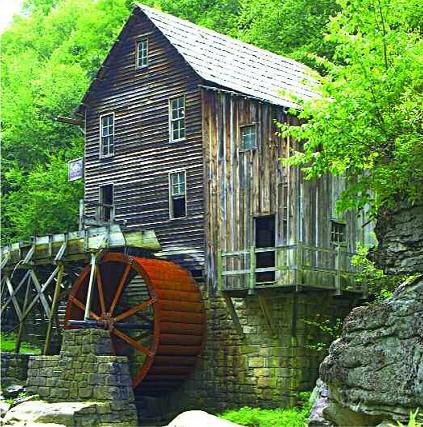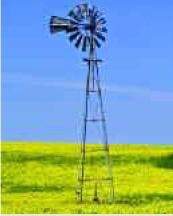
Humans have long been harnessing the power of the wind, and wind energy is now the fastest-growing energy source on earth. A wind turbine is simply a device that converts the kinetic energy of wind into mechanical energy. If that energy is used directly by machinery, such as a water pump or grain mill, as a rule, the machine is referred to as a windmill. However, if that mechanical energy is then transformed into electricity, the device is more correctly termed a wind generator or wind turbine.
Contemporary home wind energy systems commonly consist of a rotor, a frame-mounted generator or alternator, a tail, a steel tower, electrical wiring, and what we call the “balance of system”: its controllers, inverters, and batteries. Through its spinning rotors, the wind turbine catches the power of the wind and turns it into motion. As in solar power systems, small turbines can be set up to feed the electrical grid and charge battery banks to provide energy to off-grid homes, or both of these can be in grid-tied homes with battery backup.
Fixed, guyed towers do not need the open drop zone that tilt-up towers call for, but they still require open space for the guy wires.
Wind generators can be divided into two general categories based on the orientation of the turbine’s axis on which the blades rotate. Generators that rotate around a horizontal axis are the most common and what we normally think of when we think of wind power. Vertical-axis generators are less frequently seen but are growing quickly in popularity, particularly in Europe.
Horizontal-Axis Wind Generators—Horizontal-axis wind generators are mounted at the top of a tower, and most are oriented into the wind by a simple tail-like fin, whereas large commercial turbines generally employ advanced wind sensors and motors to align themselves. Inside, gears convert the relatively slow movement of the blades into high rpm motion needed for generating sufficient levels of electricity.

Windmills for pumping water and generating electricity were once common across rural America before the electrification projects of the 1930s and 1940s.
The Growing Power of Wind Power
Critics often say large-scale wind energy is inconsistent, unattractive, hazardous to wildlife, and financially impractical. But larger, quieter, and more productive wind turbines are emerging across America. Some states, such as New York and California, require that utilities obtain a specific percentage of their electricity from wind. In 2007, Texas surpassed California in installed wind power capacity. The Lone Star State now has the potential to power more than half a million American homes. More than two-dozen states have wind farms capable of generating nearly ten gigawatts of electricity, more than enough to power two million homes, and at prices increasingly competitive with natural gas, nuclear power, and so-called “clean coal.” The price of a kilowatt-hour of electricity generated by wind now averages about four cents, an 80 percent decrease from twenty-five years ago.

A quarter of the U.S. population lives in areas potentially suitable for small-scale wind power.
Vertical-Axis Wind Generators—As you might imagine, vertical-axis wind generators have their rotor shaft running vertically. The benefits of this system is that they are placed closer to the ground, so a large tower is not required to support it, and it need not be actively oriented into the wind. The downside is that they are habitually affected by a stressful torqueing action as well as by a drag effect created when the vertical blades rotate into the wind. It can also be difficult to mount vertical-axis turbines on towers to capture greater wind speeds, requiring that they function in the turbulent, weaker wind currents near the ground, which translates to lower energy production.
Swept Area and Wind Speed
Energy generation from wind turbines is influenced by two primary factors: rotor diameter and wind speed. Simply put, the more area the rotor blades cover, the more energy you will capture. The speed and volume of the wind you can capture at your site are the best gauges of your potential electrical output. Since wind power is relative to wind speed cubed, minute variances in average wind speed represent immense boosts in accessible wind power. Wind experts are quick to point out, however, that ground clutter and natural features at your site such as trees, your own home, and hillsides all increase turbulence and decrease wind speed. This deprives a wind generator of potential energy and must be taken into account when installing a home-sized wind system.
Evaluating Wind Energy at Your Site
A wind generator big enough to supply a worthwhile part of the electricity considered necessary for a typical American home is estimated to need at least one acre of property. Fortunately, more than a quarter of homes in this country sit on sites appropriate to harvesting small-scale wind energy. As with solar power, wind systems frequently have high initial costs but modest or no operating expense for the remainder of the system’s twenty- to thirty-year life. The practicality of a micro wind system depends on several factors, such as the existing wind at your location sufficient to cover your energy requirements, regulatory or zoning ordinances that bar setting up a wind turbine in your neighborhood, rebates and incentives available, and whether your investment’s payback justifies the expense.
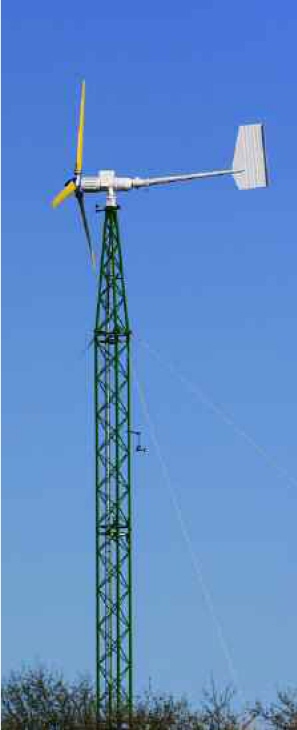
The NowHouse is a modular single-family home assembled for display in parking lot A of the Pac Bell Park. It was designed by architect Toby Long and built by Clever Homes. The home was originally meant to be auctioned for sale on eBay but was eventually donated to the city of San Francisco. An energy-saving plus for this beautiful home is that it has wind energy capability.


The good news is that wind power can be one of the most financially sensible, sustainable energy systems a homeowner can buy. Depending on the available wind at your homesite, a micro wind power system can cut your utility expenses from 50 to 90 percent, eliminate the need to string power lines to new homes and remote sites, avert power outages, and cut your contribution to greenhouse gases.
If the wind blows regularly at your location, a small-scale wind energy system is probably a good investment. First, you need to research your annual wind speeds and the prevailing direction of the wind where you live. If you live in varied terrain with lots of trees, hills, or rocky outcroppings, you have to select the installation site carefully to avoid sheltered or highly turbulent areas. Ideally, the turbine should be situated upwind of houses and trees, and a minimum of thirty feet above anything within one hundred yards of the tower.
Another way to judge the wind resource is to obtain average wind speed information from a local airport. However, be aware that local terrain differences and other factors might cause the wind speed supplied by your airport to be different from your particular location, and bear in mind that airport wind speed is generally measured at only twenty to thirty feet above the ground. Since average wind speed increases with height, your wind speed atop a hundred-foot tower could be more than 25 percent greater. The National Climatic Data Center gathers this data from airports across the

A cutting-edge vertical access wind turbine.
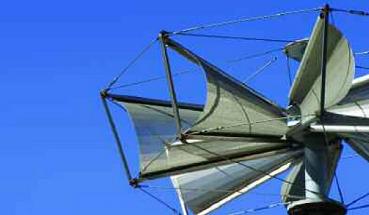

It is often wise to supplement wind power with solar or hydropower for consistent power production.
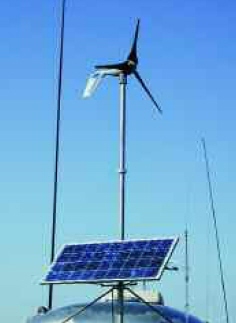
country and offers wind information for sale, but your renewable energy retailer or installer should give you a wind resource report based on geological and satellite data as part of your system design and installation plan.
Wind resource maps online also can be utilized for estimating the wind resource in your location. Usually, the highest average annual wind speeds in this country are found near the seashore, on ridgelines, and in the Midwest. However, countless areas have winds powerful enough to power a micro wind generator. More detailed wind resource information, including the summaries of wind data from approximately 1,000 airports, is available in the Wind Energy Resource Atlas of the United States, published by the U.S. Department of Energy, and can be found at the National Wind Technology Center Web site (www.nrel.gov/wind/) and the Department of Energy’s Wind Powering America Web site (www.windpoweringamerica.gov).
Whether your system is grid tied or stand alone, you must also factor in the distance between the wind generator and your house (the wire run) since a considerable amount of electricity may be lost in transit if the distance is too great. Installing greater lengths of wire or larger gauge wire also raises your system price. Because wire run losses are smaller with alternating current (AC) as compared to direct current (DC), if you have a lengthy wire run, it is prudent to invert DC to AC.
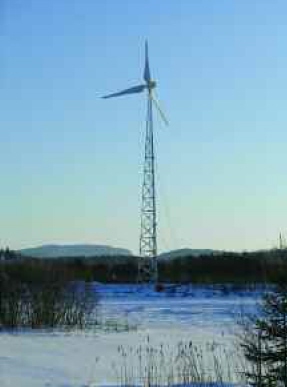
Wind turbines should be installed at least 30 feet above any turbulence-producing obstructions within 300 feet of the tower.
Local Regulations
When considering potential sites for your wind turbine, be certain to verify land use laws, zoning regulations, and building codes for ordinances thatmight affect installation of a wind turbine on your property. Many locales restrict tower height or require a clear zone around your tower in case it falls over (this rarely happens). Despite the fact that wind turbines are vastly more visually pleasing than power lines, generally unfounded complaints about noise, wildlife impact, and aesthetics are raised regarding wind turbines by communities more than against any other renewable energy system, so be prepared. Nevertheless, wind power is gaining acceptance rapidly as we enter what promises to be a golden age of green power, so it is getting easier for renewable energy pioneers every day.
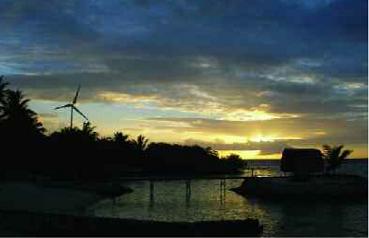
Wind energy is now the fastest-growing energy source on earth.
Turbine Sizing
The size of the wind turbine your home requires depends on how you plan to use it. A typical home uses approximately 10,000 to 12,000 kilowatt hours of electricity annually. Depending on the wind resource at your site, you would need an expensive five- to fifteen-kilowatt-hour turbine to meet this demand. Conversely, a more economical one-kilowatt-hour wind turbine might be sufficient to cover the requirements of a household needing 250 to 300 kilowatt hours per month at a site with an annual average wind speed of fourteen miles per hour or better. Manufacturers and installers will give you the expected annual energy output of the turbines they sell according to your annual average wind speed.
Towers
Wind-energy experts will always tell you that the higher you go, the better the wind. Because wind speeds increase with height over level ground, wind turbines are erected atop a tower. In essence, the greater the height of your tower, the more power your wind
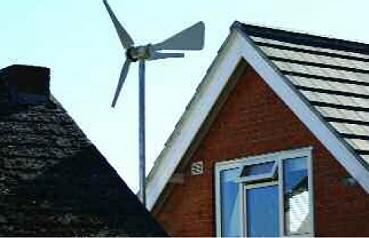
Humans have used wind power for centuries, but after decades of being forgotten, wind is now seeing a dramatic resurgence worldwide.
turbine can generate. The tower also lifts the turbine above air turbulence at ground level. A common maxim is to mount the wind turbine on a tower so that the tips of the rotor blades are a minimum of thirty feet above any obstacle that is within 300 feet.
Experiments have demonstrated that fairly small increases in tower height can give higher rates of power production more than enough to justify the added cost. For instance, to raise a ten-kilowatt-hour turbine from a sixty-foot tower to a one-hundred-foot tower produces a 10 percent increase in system cost but will produce about 25 percent more energy. Mounting turbines on rooftops is not recommended because wind turbines vibrate and therefore transmit that vibration to the structure on which they are mounted. This can lead to annoying noise levels and structural damage to the building, and roofs can create excessive turbulence that can shorten the life of the turbine and limit its effectiveness.
The three basic tower types are tilt-up towers, fixed towers, and freestanding towers:
Tilt-Up Towers—Although tilt-up towers are more costly, these give the homeowner a painless way to perform repairs on micro turbines of five kilowatts or smaller. Moreover, you or your installer will never have to climb the tower, and if there are mechanical issues with the turbine, you can generally lower it in less than an hour and raise it again just as quickly once repairs are complete. The major downside of tilt-up towers is the footprint required since you need an open area for the tower to lie down.
Fixed, Guyed Towers—A fixed, guyed tower is erected once and does not tilt down again. Guy wires hold it in place, and any maintenance is done by climbing the tower. Fixed, guyed towers do not need the open drop zone that a tilt-up tower needs, but you still must have open space for the guy wires. Costs for these are comparable to tilt-up towers, but they can be installed on many sites that will not accommodate a tilt-up tower because they don’t need as much cleared level space.
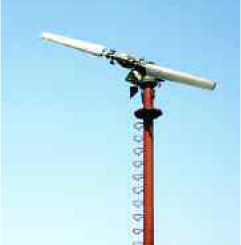

A less-common two-bladed horizontal-access turbine.
Freestanding Towers—If aesthetics, not cost, are a primary concern, a freestanding tower might be your first choice. There are no guy wires, no tilting involved, and freestanding towers only need a modest space for the tower base. Freestanding towers take two basic forms. Both types are usually assembled on the ground and lifted with a crane. The most common version is the three-legged style, with tubular legs connected by angle iron braces. The other option is a monopole tower—a single tube similar to what is used for utility-scale wind turbines, only smaller. These are often quite expensive and are out of reach financially for most small-scale renewable energy users. A freestanding tower will cost at least one-third to one-half more than a tilt-up or fixed, guyed tower.
Balance of System
The balance of system parts that you need in addition to the turbine and the tower depends on your application. Most manufacturers and dealers will provide you with a system package that includes all the components you need for your application. The balance of system required will also depend on whether the system is grid connected, stand alone, or part of a hybrid system. For a residential grid-connected application, the balance of system parts may include a controller, storage batteries, inverter, and wiring.

Wind turbines should not be installed on rooftops or attached to buildings where vibrations can cause undesirable noise or structural damage.

This is a modern version of the eggbeater-style “Darrieus” vertical-axis wind turbine developed by French inventor Georges Jean Marie Darrieus in the 1920s.
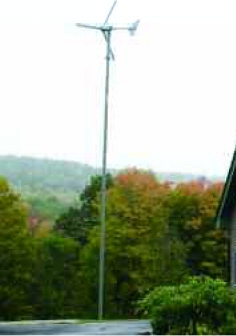
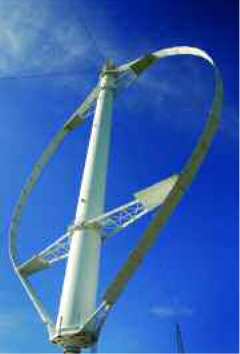
Cost
Installation costs vary greatly depending on local zoning, permits, and utility interconnection costs. A small turbine can cost anywhere from less than $1,000 for small “camp” sizes to $50,000 for large home systems, depending on size, application, and service agreements with the manufacturer. The American Wind Energy Association (AWEA) estimates that a ten-kilowatt home wind system costs approximately $32,000 compared to a similar photovoltaic solar energy system that would cost over $80,000. Wind energy becomes more cost-effective as the size of the turbine’s rotor increases. Although small turbines cost less in initial outlay, they are proportionally more expensive.
The cost of an installed residential wind energy system with an eighty-foot tower, batteries, and inverter typically ranges from $15,000 to $50,000 for a three- to ten-kilowatt system. Although wind energy systems involve a significant initial investment, they can be competitive with conventional energy sources when you account for a lifetime of reduced or avoided utility costs. The length of the payback period— the time before the savings resulting from your system equals the cost of the system itself—depends on the system you choose, the wind resource on your site, electricity costs in your area, and how your wind system is used. For example, if you live in California and have received the 50 percent rebate of your small wind system, and if you have net metering and an average annual wind speed of fifteen miles per hour at your site, your simple payback would be approximately six years.
The Bottom Line
The Wind Energy Payback Period Workbook found at www.nrel.gov/wind/docs/ is a spreadsheet tool that can help you analyze the economics of a small-wind electric system and decide whether wind energy will work for you. It asks you to provide information about how you are going to finance the system, the characteristics of your location, and the properties of the system you are considering. It then provides you with a payback estimate measured in years. If it takes too long to recoup your investment— i.e., the number of years for payback exceeds the life of the system—wind energy may not be desirable for you.
